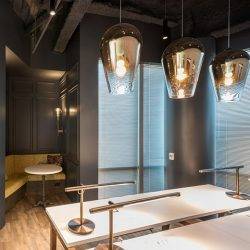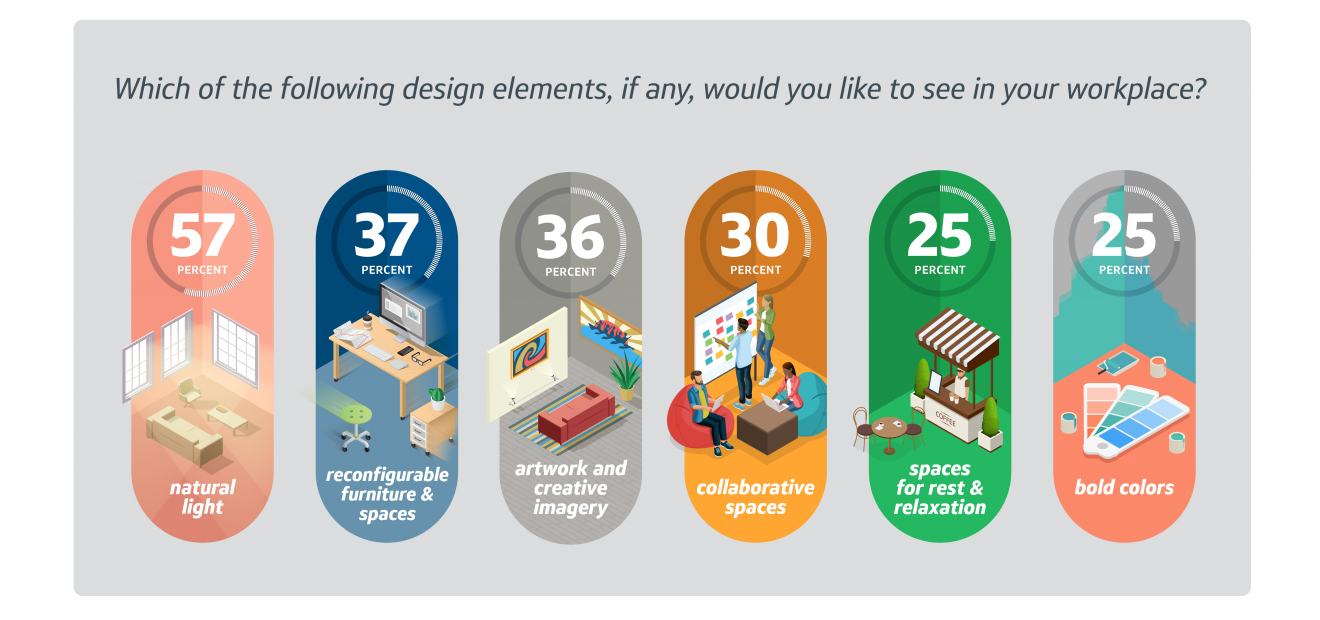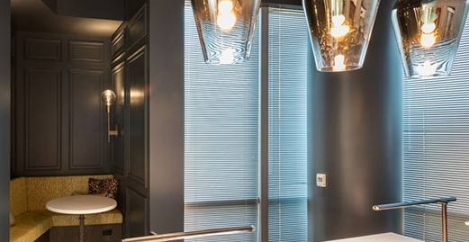August 1, 2018
Flexibility, daylight and a well-designed office are amongst most desirable workplace features
 Capital One has published the results of its latest survey of US full-time professionals for their thoughts on workplace design and the working environment as it relates to their productivity, innovation and collaboration with colleagues. According to the resulting 2018 Work Environment Survey of 3,500 office based respondents in urban centres across the US, many value flexibility and workplace design, particularly when evaluating whether to stay at their current job or consider a new employment opportunity. Employees also place a great deal of focus on technology, design elements such as lighting and agile workspaces, and personal wellbeing.
Capital One has published the results of its latest survey of US full-time professionals for their thoughts on workplace design and the working environment as it relates to their productivity, innovation and collaboration with colleagues. According to the resulting 2018 Work Environment Survey of 3,500 office based respondents in urban centres across the US, many value flexibility and workplace design, particularly when evaluating whether to stay at their current job or consider a new employment opportunity. Employees also place a great deal of focus on technology, design elements such as lighting and agile workspaces, and personal wellbeing.
Main findings:
Flexibility is crucial: Professionals increasingly want to work at companies that accommodate a variety of work styles with flexible design, workspaces and hours. In fact, 85 percent of office professionals surveyed believe flexible workplace design is important and 83 percent said they have their best ideas when working in flexible space options. Flexible schedules also prove to be crucial to talent attraction and retention – 73 percent of workers say a flexible schedule is in their top two reasons to stay with a company, and flexible hours was the number one thing workers cited when asked what they expect from their next employer (58 percent).
Tech expectations: Employee expectations are high across the board, and technology is no exception. A majority of professionals (85 percent) across the country say it’s important that their next employer be an early adopter of technology, quick to invest in and implement new tech.
Office design drives innovation: For the second year in a row, the majority of office professionals believe companies can’t encourage innovation unless their workplace environment is innovative (79 percent). Those at the executive level feel even more strongly about this, with 87 percent agreeing office design is key to encouraging innovation.
Design elements: The most desired design elements for workspaces include: natural light (57 percent), easily reconfigurable furniture and spaces (37 percent), artwork and creative imagery (30 percent), collaborative spaces (30 percent), and a tie (25 percent) for bold colours and spaces for rest and relaxation.
Options impact productivity: Offering different kinds of workspaces for employees is crucial, as 80 percent of respondents say they are more productive when they move to a different room or environment while working.
 Location: When considering a new job, 2 out of 3 (66 percent) full-time professionals believe that workplace design and environment is equally important or more important than office location. Executive level employees feel even more strongly about this, with more than 3 out of 4 (76 percent) saying workplace design is as, or more, important than location.
Location: When considering a new job, 2 out of 3 (66 percent) full-time professionals believe that workplace design and environment is equally important or more important than office location. Executive level employees feel even more strongly about this, with more than 3 out of 4 (76 percent) saying workplace design is as, or more, important than location.
Health & wellness benefits: Most office professionals said their company doesn’t currently offer mother’s nursing room (82 percent); environmentally friendly programs (77 percent); quiet, reflective spaces (72 percent); or onsite health centre/wellness programs (71 percent). When asked to prioritise a single onsite benefit, the top responses were healthy food and beverage options (39 percent); onsite health centre/wellness programs (33 percent); relaxation/social areas (32 percent); and quiet, reflective space (29 percent).
Flexibility: Flexible hours is still the top priority for professionals across these five markets, with 64 percent in 2017 and 65 percent in 2018 expecting it from the next company they work for. Responses indicated an increase in the importance of flexible workplace design, with 88 percent finding it important in 2018, up three percent from 85 percent in 2017. In 2018, 84 percent of professionals from the five markets surveyed said that they had their best ideas when they are able to use flexible workspace options, up two points from 2017 at 82 percent.
Preferred design elements: The top four choices in both years were natural light; easily reconfigurable furniture and spaces; artwork and creative imagery; and collaborative spaces (the same top four at the 2018 national data).
Prioritising wellbeing: When asked which benefits professionals would most like to have at their company if it meant forgoing the rest, the top four responses were onsite healthy food and beverage options; relaxation/social areas; onsite health centre/wellness programs; and quiet, reflective space (the same top four at the 2018 national data).
























